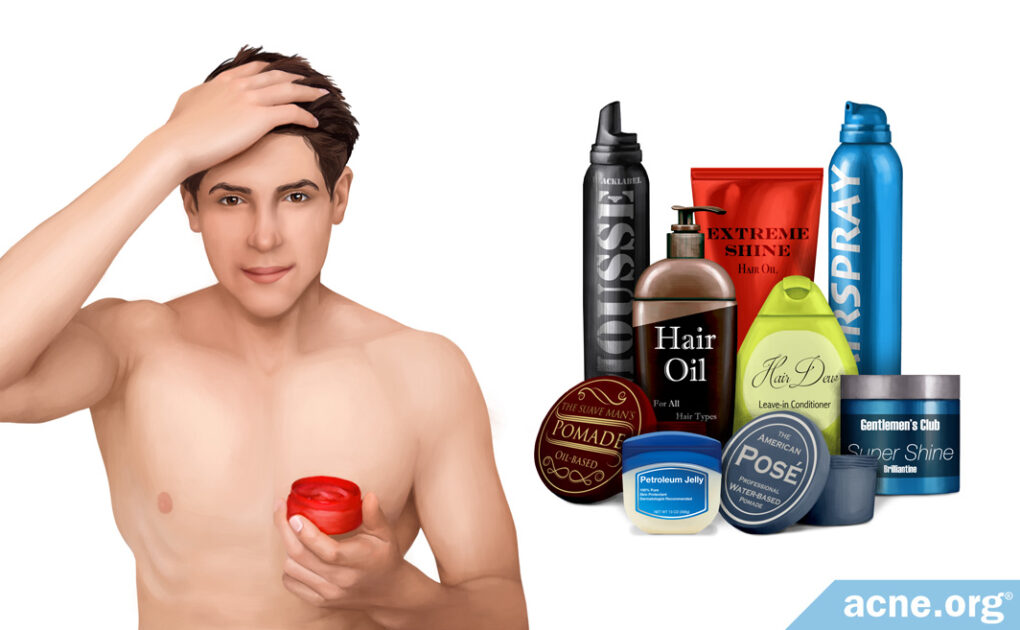Certain Leave-in Hair Products Such as Pomades, Brilliantine, and Some Oils, May Cause Acne

The Essential Info
Some leave-in hair products like pomades, hair oils, brilliantine, gels, sprays, and conditioners may contain ingredients that can clog pores and lead to acne breakouts, particularly around the hairline where the product is most likely to contact the skin.
Tips to Avoid It:
- Check the ingredient list and avoid products that contain pore-clogging ingredients
- Change pillowcases regularly and cover your hair before bed with a scarf or bonnet
- Avoid touching the hair and then touching the skin

The Science
- Leave-in Hair Product Ingredients That Cause Clogged Pores
- Tips for Preventing Acne Caused by Hair Products
Leave-in hair products like pomades, oils, gels, sprays, mousses, conditioners, brilliantines, and jellies are meant to be left in the hair after they are applied.
Some of these products may contain ingredients that can be pore-clogging (comedogenic), and this is an issue because when you apply products to your hair, you can inadvertently get some of the product onto your skin, especially at the hairline.
You can also transfer them to other parts of the face if you touch your hair and then touch your face.
Hair products might also come into contact with your skin from your pillowcase. When you sleep, your hair products can rub off on your pillowcase. Then, when you toss and turn while you sleep, your skin can pick up this hair product.
Let’s have a look at some of the specific ingredients common to hair care products that might aggravate acne.
Leave-in Hair Product Ingredients That Cause Clogged Pores
There are several ingredients that scientists have determined will likely clog pores and result in acne, many of which are found in hair care products. A list of these comedogenic ingredients can be found below. It is wise for people with acne to avoid the ingredients in List 1, as these are highly likely to cause acne. The ingredients in List 2 may cause acne in some individuals, but there is less research on how comedogenic these ingredients are.
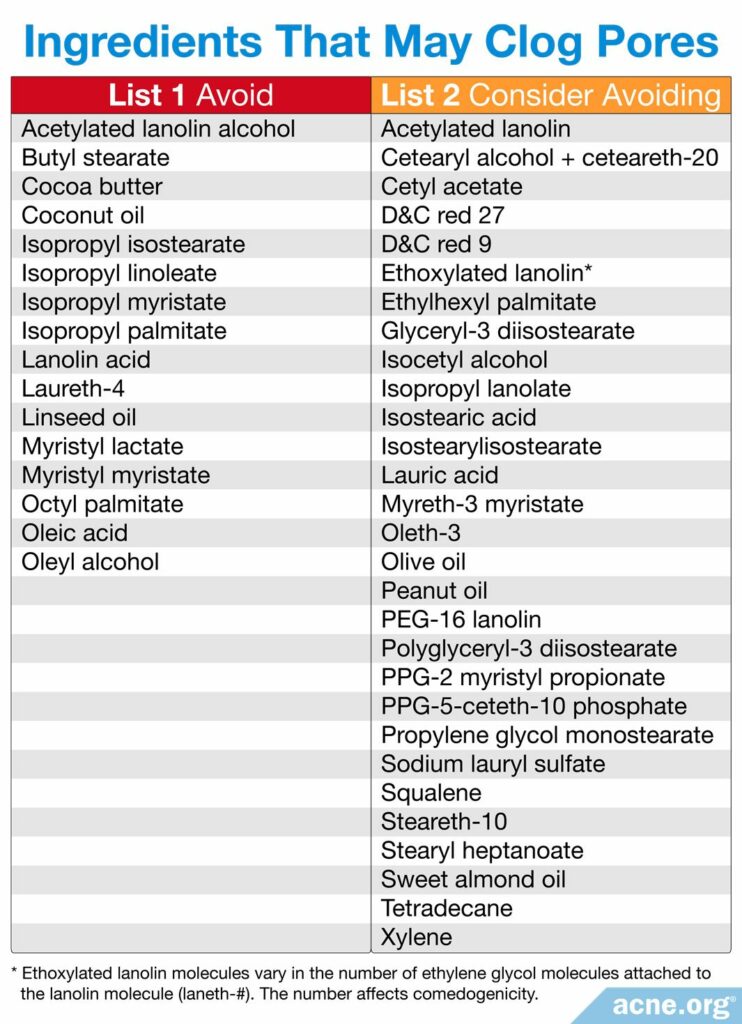
Products that contain higher concentrations of these comedogenic ingredients are more likely to cause acne than products that contain lower concentrations. A good rule of thumb is to look at the ingredient list on the back of a product and avoid the product if a comedogenic ingredient is listed in the first seven (7) ingredients.
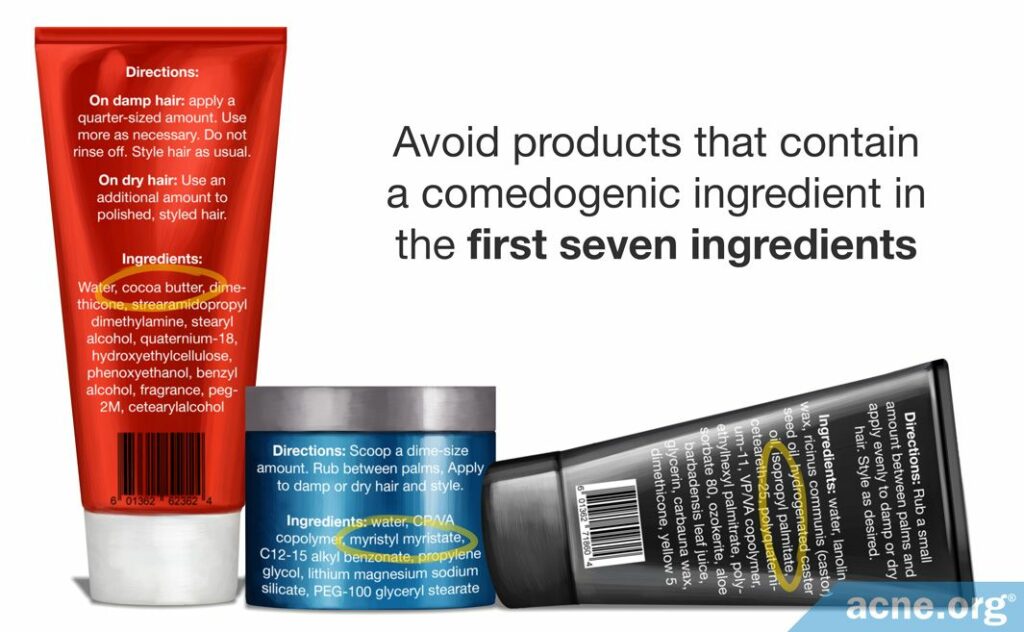
Now let’s look at some of the common leave-in hair products on the market that may be of particular concern.
Pomades
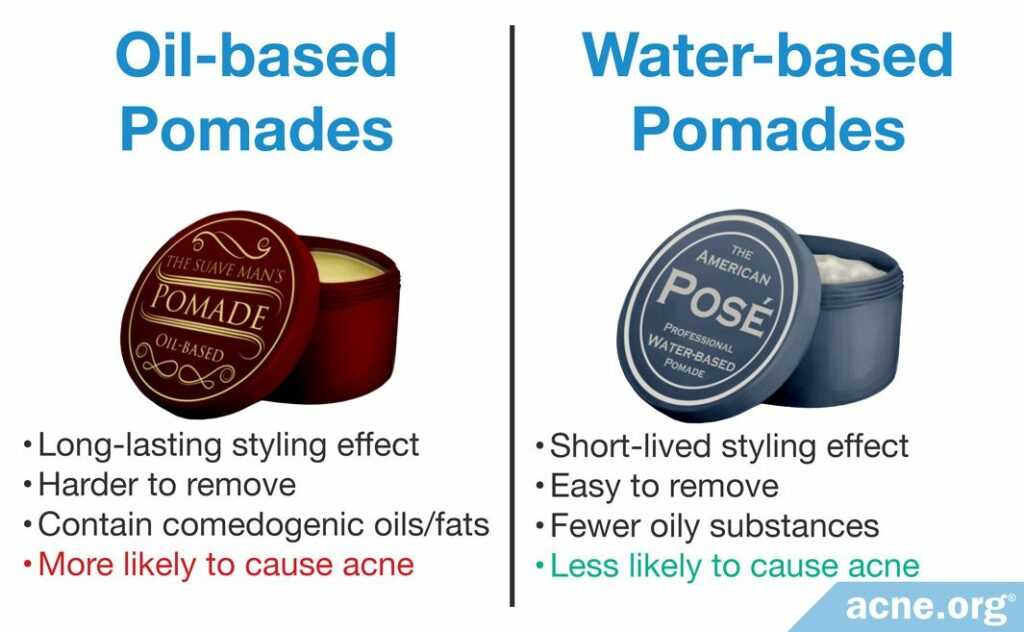
Pomades are hair products most commonly used by people of African descent to moisturize and style the hair. Pomades do not dry out after application and can remain in the hair even after several rounds of shampooing.1 Acne caused by these products is commonly called “pomade acne” and usually occurs in the form of whiteheads as well as inflamed (red) pimples along the frontal hairline, on the forehead, and on the temples.2 There are two main types of pomades.
- Oil-based pomades: Oil-based pomades are long lasting, and often can only be removed from the hair with the use of strong shampoos made specifically for oily hair. These types of pomades are more likely to cause acne because they often contain comedogenic ingredients like certain oils and/or acetylated lanolin.
- Water-based pomades: Water-based pomades last for a shorter period of time than oil-based pomades because they contain fewer oily ingredients. Although they are not as capable of shaping and styling the hair and keeping it held in that position as oil-based pomades, they are easier to wash out of the hair and less likely to bring about flareups of acne.3
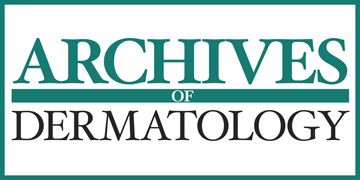
A 1970 study published in Archives of Dermatology examined the ability of five different oil-based pomades to cause acne in 735 men of color. The researchers found that daily use of oil-based pomades resulted in numerous whiteheads around the temples and forehead. Additionally, they found that applying the pomade directly to the skin resulted in the formation of clogged pores and inflammatory acne. Therefore, oil-based pomades should be avoided.4,5
Pure oils
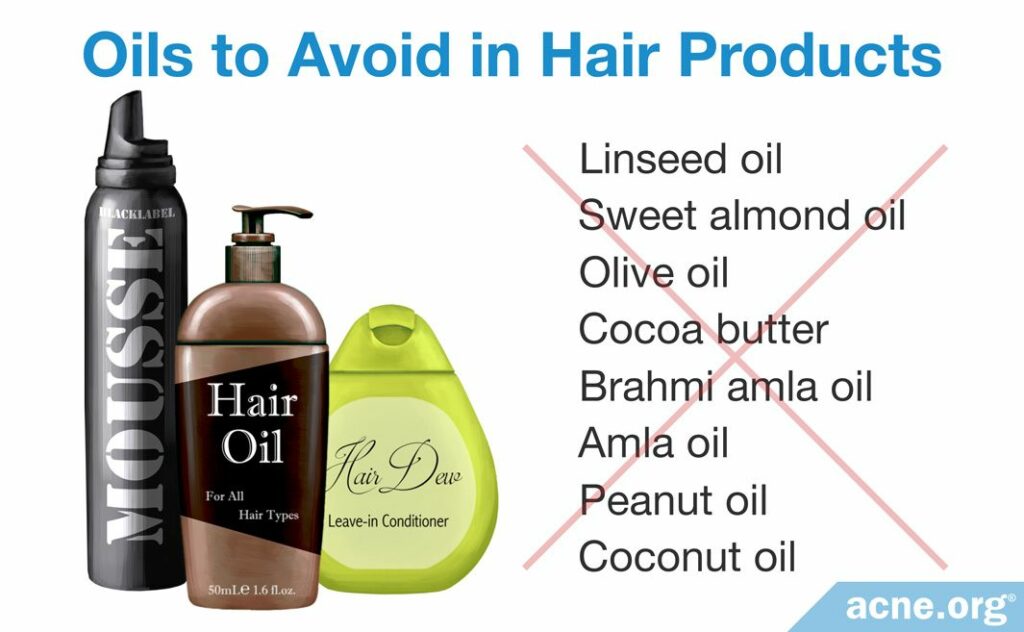
People use oils as protective agents for hair, since some oils can help repair dry and damaged hair, protect the hair from additional damage, and impart shine to the hair.1,5 However, several of these oils range from slightly to highly comedogenic and can cause acne, including:
- Linseed oil
- Cocoa butter
- Coconut oil
- Peanut oil
- Olive oil
- Sweet almond oil
- Amla oil
- Brahmi amla oil
People with acne-prone skin should avoid using these oils altogether, opting instead for non-comedogenic alternatives like jojoba oil or castor oil.6 If that is not an option, carefully avoid the skin around the hairline during application.7
Brilliantine
Brilliantine is a perfumed oily liquid that can be added to a man’s hair to soften it or give it a shiny appearance. However, like pomades, brilliantine is a greasy product, and research has found that it can cause acne in some people.7
Hair gels, sprays, mousses (avoid the ones with comedogenic ingredients)
Hair gels, hair sprays, and mousses are all leave-in hair products that are used for styling and shaping of the hair. Unlike pomades, these products are designed to dry once on the hair and often contain comedogenic ingredients. So it is advisable for people with acne-prone skin to check the product labels for comedogenic ingredients, and avoid hair gels, sprays, or mousses that contain them.8,9
Leave-in conditioners (avoid the ones with comedogenic ingredients)
Leave-in hair conditioners are hair products used on wet or dry hair to moisturize the hair. They can contain comedogenic ingredients like certain oils that, if left on the hair, may cause breakouts. Therefore, people with sensitive or acne-prone skin should be cautious when choosing these products.4,10
Vaseline® (should be safe)
Vaseline®, or petroleum jelly, is a common ingredient found in several cosmetic and hair products. While several older research studies concluded that petroleum jelly caused clogged pores, more recent research has determined that it is safe for acne-prone skin.7
Tips for Preventing Acne Caused by Hair Products
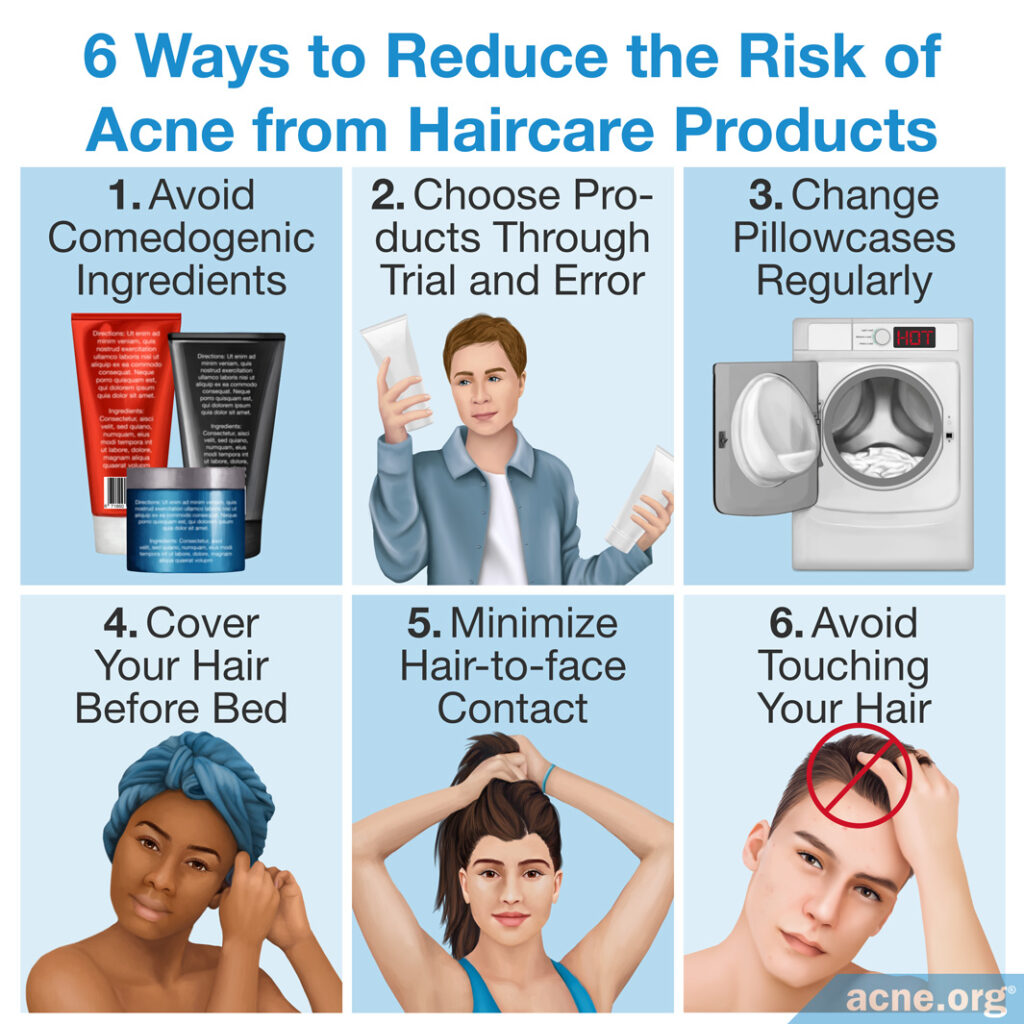
- Avoid comedogenic ingredients: Always check the product labels on leave-in hair products and, if a product contains comedogenic ingredients, particularly in the first seven ingredients on the label, avoid that product or limit its use. To be extra safe, you can do this when selecting rinse-out hair products like shampoos and rinse-out conditioners as well.12
- Choose products through trial-and-error: If breakouts occur after using a new product, discard that product and try a different one.
- Change your pillowcase regularly: Leave-in hair products can rub off on a pillowcase during sleep and then transfer to the skin. Changing pillowcases on a regular basis decreases the chance that ingredients left on the pillowcase will come into contact with the face.
- Cover your hair before bed: Wrapping the hair with a cover, like a hair scarf or bonnet, before bed will limit hair-to-skin contact.
- Minimize hair-to-face contact: Certain hairstyles, like bangs, cause hair and leave-in hair products to contact the face more regularly. Choosing hairstyles that minimize hair-to-face contact decreases the chance that comedogenic ingredients from hair products will contact the face and cause acne.
- Avoid touching hair: Touching the hair can transfer a leave-in hair product to your hands. Then, your hands may touch the face, transferring some of the leave-in hair product to the face. Avoiding touching the hair can prevent this.
References
- Gavazzoni Dias, M. F. Hair cosmetics: an overview. Int J Trichol 7, 2 – 15 (2015). http://www.ijtrichology.com/article.asp?issn=0974-7753;year=2015;volume=7;issue=1;spage=2;epage=15;aulast=Gavazzoni
- Lawson, C. N., Hollinger, J., Sethi, S., Rodney, I., Sarkar, R., Dlova, N. & Callender, V. D. Updates in the understanding and treatments of skin & hair disorders in women of color. Int J Womens Dermatol 3 (1 Suppl), S21-S37 (2017). https://pubmed.ncbi.nlm.nih.gov/28492036/
- Pomade, https://en.wikipedia.org/wiki/Pomade
- Davis, E. C. & Callender, V. D. A review of acne in ethnic skin: pathogenesis, clinical manifestations, and management strategies. Journal Clin Aesthet Dermatol 3, 24 – 38 (2010). https://www.ncbi.nlm.nih.gov/pubmed/20725545
- Plewig, G., Fulton, J. E. & Kligman, A. M. Pomade acne. Arch Dermatol 101, 580 – 4 (1970). https://www.ncbi.nlm.nih.gov/pubmed/4245751
- Yusuf, A. K., Mamza, P. A. P., Ahmed, A. S., & Agunwa, U. Extraction and characterization of castor seed oil from wild Ricinus communis Linn. International Journal of Science, Environment and Technology 4, 1392-1404 (2015). https://www.researchgate.net/profile/A-Yusuf/publication/282641536_EXTRACTION_AND_CHARACTERIZATION_OF_CASTOR_SEED_OIL_FROM_WILD_RICINUS_COMMUNIS_LINN/links/5614c96408ae4ce3cc63fdea/EXTRACTION-AND-CHARACTERIZATION-OF-CASTOR-SEED-OIL-FROM-WILD-RICINUS-COMMUNIS-LINN.pdf
- Kligman, A. M. & Mills, O. H. Acne cosmetica. Arch Dermatol 106, 843 – 850 (1972). https://www.ncbi.nlm.nih.gov/pubmed/4264346
- Hairstyling product, https://en.wikipedia.org/wiki/Hairstyling_product
- Corbett, J. F. The chemistry of hair-care products. J Soc Dyers Col 92, 285 – 303 (1976). https://onlinelibrary.wiley.com/doi/abs/10.1111/j.1478-4408.1976.tb03293.x
- Alessandrini, A. & Piraccini, B. M. Essential of hair care cosmetics. Cosmetics 3, 34 (2016). https://www.mdpi.com/2079-9284/3/4/34
- Kligman, A. M. Petrolatum is not comedogenic in rabbits or humans: A critical reappraisal of the rabbit ear assay and the concept of “acne cosmetic.” J Soc Cosmet Chem 47, 41 – 48 (1996). http://pdfs.semanticscholar.org/8d16/fbe436c6726b5e1a7ae632ae44f694d5b4a4.pdf?_ga=2.251999689.1914568260.1557834951-363438195.1557834951
- Tarun, J., Susan, J., Suria, J., Susan, V. J. & Criton, S. Evaluation of pH of bathing soaps and shampoos for skin and hair care. Indian J Dermatol. 59, 442-444 (2014). https://pubmed.ncbi.nlm.nih.gov/25284846/
 Acne.org Products
Acne.org Products